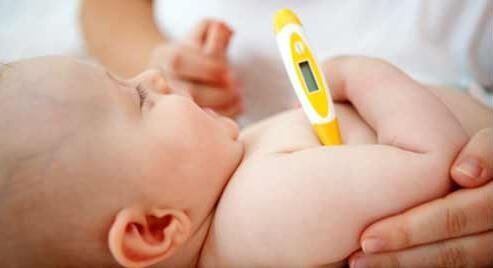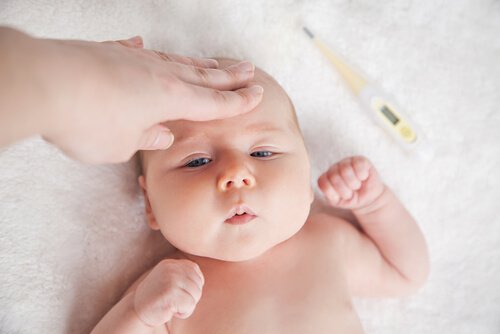Tricks to Lower Fevers in Babies

It’s natural for mothers to worry if their baby’s body temperature changes. However, this won’t happen for a long time. Once you learn what you can do at home to lower fevers in babies, you’ll feel much more confident.
From birth, babies struggle to adapt to the temperature of their new environment. It’s a somewhat abrupt change for them. Therefore, you need to try and keep the temperature similar to what they experienced in the womb.
Normal temperature for babies
Babies are born with the rectal temperature of approximately 97-100ºF. In this sense, the auxiliary temperature is lower than the groin, which is less than the rectum.
Babies lose heat through breathing, muscular activity and perspiration through the skin.
When babies’ temperature rises the first time, don’t worry. It doesn’t necessarily mean they have an infectious disease, virus, bacteria or other problem.
In some cases, this increase could be due to excess clothing. However, it could also be the start of some sickness in the worst situations.
Rise in body temperature could occur at night when it’s impossible to leave the house and go to the doctor. That’s when you’ll need to apply these useful tricks to lower fevers in babies.
Remember, of course, these are only temporary solutions to use in the moment. If the condition persists, be sure to visit the pediatrician as soon as possible.
Tricks you can use to lower fevers in babies
Keep the baby’s body ventilated
Make sure your baby isn’t too warm. This can cause his body temperature to rise. When a fever breaks, opt for clothes made of cotton. These are great for perspiration and are much fresher.

Don’t bathe with warm water
Many mothers make the mistake of showering their baby with very cold water. They don’t know that this could actually make the fever worse.
We recommend using room temperature water. Sudden temperature shocks aren’t good for anyone, much less babies. Lukewarm water is the best option.
Apply compresses
This trick has been passed down from generation to generation. Compresses are very effective to lower fevers.
Soak them in cold water, but not freezing. Also, make sure to place them in strategic places. For example, the forehead, soles of the feet, palms and the back of the neck.
If you notice the fever reaching above 101ºF, go immediately to the health center. This is important if you’ve already tried all the tricks to lower the fever.
Keep your baby hydrated
It’s very important for your baby to get lots of liquid. When there’s an increase in body temperature, babies lose water through perspiration.
Avoid dehydration at all costs. To do this, give him fresh juices, like watermelon. Chicken broth or homemade whey can also be very helpful.
Coffee poultices
These poultices have been very useful for many mothers. The coffee needs to be ground and wet, just like with cold compresses.
However, for these, just place them on the baby’s feet and hands. That’s the safest way to use them.
Sliced raw potato
This is also good for lowering body temperature in babies. Like coffee poultices, you can place them on the baby’s feet and palms.

Controlled space ventilation
When babies have a high temperature, keep them in a room with good air flow. However, make sure it doesn’t have cold or strong drafts.
Keep your baby lying down and calm. That way, he won’t be agitated and the fever can go down more quickly.
Make sure to check on the fever every 30 minutes. If you notice the fever reaching above 101ºF, go immediately to the health center. This is important if you’ve already tried all the tricks to lower the fever.
It’s important that you don’t self-medicate your baby. While you can try these natural tricks, don’t try medications you have at home. It’s better to follow a specialist’s instructions.
It’s natural for mothers to worry if their baby’s body temperature changes. However, this won’t happen for a long time. Once you learn what you can do at home to lower fevers in babies, you’ll feel much more confident.
From birth, babies struggle to adapt to the temperature of their new environment. It’s a somewhat abrupt change for them. Therefore, you need to try and keep the temperature similar to what they experienced in the womb.
Normal temperature for babies
Babies are born with the rectal temperature of approximately 97-100ºF. In this sense, the auxiliary temperature is lower than the groin, which is less than the rectum.
Babies lose heat through breathing, muscular activity and perspiration through the skin.
When babies’ temperature rises the first time, don’t worry. It doesn’t necessarily mean they have an infectious disease, virus, bacteria or other problem.
In some cases, this increase could be due to excess clothing. However, it could also be the start of some sickness in the worst situations.
Rise in body temperature could occur at night when it’s impossible to leave the house and go to the doctor. That’s when you’ll need to apply these useful tricks to lower fevers in babies.
Remember, of course, these are only temporary solutions to use in the moment. If the condition persists, be sure to visit the pediatrician as soon as possible.
Tricks you can use to lower fevers in babies
Keep the baby’s body ventilated
Make sure your baby isn’t too warm. This can cause his body temperature to rise. When a fever breaks, opt for clothes made of cotton. These are great for perspiration and are much fresher.

Don’t bathe with warm water
Many mothers make the mistake of showering their baby with very cold water. They don’t know that this could actually make the fever worse.
We recommend using room temperature water. Sudden temperature shocks aren’t good for anyone, much less babies. Lukewarm water is the best option.
Apply compresses
This trick has been passed down from generation to generation. Compresses are very effective to lower fevers.
Soak them in cold water, but not freezing. Also, make sure to place them in strategic places. For example, the forehead, soles of the feet, palms and the back of the neck.
If you notice the fever reaching above 101ºF, go immediately to the health center. This is important if you’ve already tried all the tricks to lower the fever.
Keep your baby hydrated
It’s very important for your baby to get lots of liquid. When there’s an increase in body temperature, babies lose water through perspiration.
Avoid dehydration at all costs. To do this, give him fresh juices, like watermelon. Chicken broth or homemade whey can also be very helpful.
Coffee poultices
These poultices have been very useful for many mothers. The coffee needs to be ground and wet, just like with cold compresses.
However, for these, just place them on the baby’s feet and hands. That’s the safest way to use them.
Sliced raw potato
This is also good for lowering body temperature in babies. Like coffee poultices, you can place them on the baby’s feet and palms.

Controlled space ventilation
When babies have a high temperature, keep them in a room with good air flow. However, make sure it doesn’t have cold or strong drafts.
Keep your baby lying down and calm. That way, he won’t be agitated and the fever can go down more quickly.
Make sure to check on the fever every 30 minutes. If you notice the fever reaching above 101ºF, go immediately to the health center. This is important if you’ve already tried all the tricks to lower the fever.
It’s important that you don’t self-medicate your baby. While you can try these natural tricks, don’t try medications you have at home. It’s better to follow a specialist’s instructions.
All cited sources were thoroughly reviewed by our team to ensure their quality, reliability, currency, and validity. The bibliography of this article was considered reliable and of academic or scientific accuracy.
- Ares Álvarez J, Morillo Gutiérrez B. Fiebre sin foco. Revista Pediatría Atención Primaria. Supl. 2021 (30): 19-28.
- Asociación Española de Pediatría de Atención Primaria. Acerca de la fiebre de vuestros hijos.
- Asociación Española de Pediatría. La fiebre representa el motivo más frecuente de consulta en urgencias pediátricas (nota de prensa). Junio 2012.
This text is provided for informational purposes only and does not replace consultation with a professional. If in doubt, consult your specialist.








